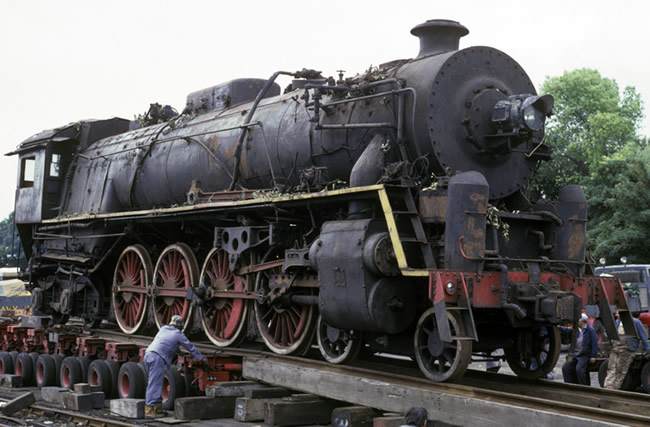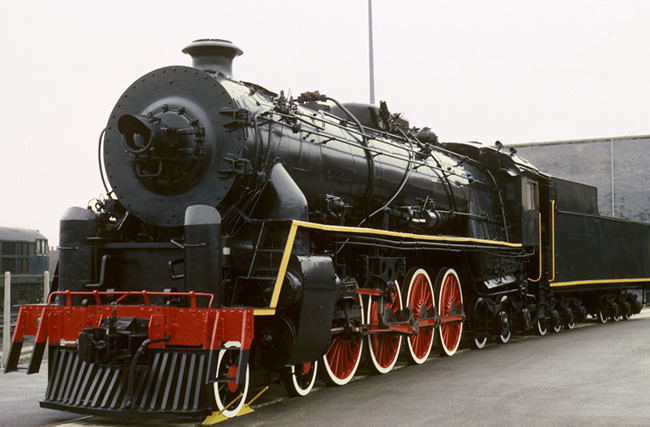When looking at an object in a museum I like to ask ‘why is this here?’ How did this particular object end up here, as opposed to some village in Sumatra or buried in a field? The ‘why’ of some objects may seem obvious – you might expect Brunel’s walking stick to have ended up at the National Railway Museum, and the same for railway posters. Presumably at some stage in the past these were given to the museum, or acquired because the museum had (in the past) direct links with the state railway?
However with the locomotive collection, the ‘why’ is sometimes not obvious. These are not the kind of things that can sit around the back of an office for 40 years. Our locomotive collection, unlike that of preserved railways, is the result of an ‘official’ approach to preservation for well over 100 years. Each loco has a history of why and how it came to be preserved that is separate to that of its working life, but often just as interesting.
When you encounter the 196 tons of the ‘Chinese Engine’ it gets even more complicated. The locomotive never ran in the UK, is well outside the British loading gauge, and came to the National Railway Museum just at the point when China was moving away from the Mao years and becoming the modern, capitalist hybrid it currently is. (Economic note: when the locomotive was donated to us in 1981, China had a trade deficit of around $1200 million, today it has a trade surplus of $544,760 million).

The Chinese government decided to present it to the National Railway Museum ‘as a gift from the people of China to people of Britain’ in 1979. But this locomotive was built in Newton le Willows in 1935. So why didn’t they donate a bona-fide Chinese built example? Part of the answer for that lies in its designer, Lt. Col Kenneth Cantlie. His father was Sir James Cantlie who was friends with the founding father of the Republic of China Dr Sun Yat Sen.
In 1896 James Cantlie had led a media campaign to rescue Dr Sun when he had been abducted by the Chinese Imperial Secret Service in London and was due to be squirreled out of the country back to China, where he was likely to have been executed. What better way to mark fraternal relations than to give the UK a locomotive associated with such an auspicious family, especially given that the designer of the locomotive Kenneth Cantlie had Sun Yat Sen as his godfather!
So whilst it is a brilliant example of a locomotive built for export, and technically quite sophisticated, it sits in our Great Hall for reasons that aren’t immediately obvious!

Reading though the files in our Search Engine, you can also play the game ‘six degrees of separation’ with the history surrounding the locomotive. In this case you can go from the founding father of the Chinese Republic to an American contemporary opera. It goes like this…
First is Dr Sun Yat Sen (1866 -1925) – Chinese nationalist and first president of China after the end of the Qing dynasty, and godfather of the locomotive’s designer, Lt. Col. Kenneth Cantlie.
Second is the ‘Boxer rebellion’- an anti-imperialist revolt that eventually led to the end of the Qing dynasty which had ruled China for over two thousand years. It was put down by an eight nation alliance in 1901 and the Imperial Chinese government was forced to pay reparations to the eight nations – UK, USA, Germany, France, Japan, Russia, Italy and Austria-Hungary. In the UK this money was held by the Boxer Indemnity fund and one of the fund’s trustees was Kenneth Cantlie. He was also (from 1929) the technical advisor to the Chinese Ministry of Railway and had a big influence in the railways of China in the inter-war period.
Third is the fact that the order for the locomotive was funded by the Boxer Indemnity fund. KF no.7 was one of a class of 24 built with funding from this source.
Fourth is the visit of US President Richard Nixon to China in 1972 which surprised the world and showed China was prepared to open up to the west after years of isolation. This would eventually (after Mao’s death in 1976) lead to the economic policy that has transformed China.
Fifth is the fact that the last time one of these locomotives was seen in service was on newsreels that accompanied Nixon’s visit to China.
Sixth is the acclaimed contemporary opera by the John Adams ‘Nixon in China’ first performed in 1987, by which time the ‘Chinese Engine’ had been on display at York for four years.
So once again railways are the thread that link different lives together. It all seems straightforward in hindsight!
The KF-7 is part of our Great Hall – find out what else you can see in our Great Hall.
Great story you forgot to mention how many in the class of locomotives.
It’s one of twenty four according to the article.
Thank you so much for this item. It is very helpful and next time I am in York I will look at the loco with renewed interest.
I returned to the museum recently after a long absence and was mightily impressed by this huge loco and its history. It’s my iPad wallpaper and I’ll be back to admire it when the rugrats are back in class.
How fast did this locomotive go?
Honestly, one of my favorite locos yall have. Mainly because of how American it is. Knuckle couplers (not all knuckles are called janies BTW), tender, and many other cosmetic aspects make it look like it could very, very American, despite being of English design and used in China.
Several Chinese locomotives run in America as well! Mainly two QJ type 2-10-2s, and a couple JS type 2-8-2 mikados! Honestly, Chinese steam is cool to me because it’s mirrors US Steam locomotives in looks and design, but it’s just different enough to be it’s own thing. At the end of the day, it’s a very interesting locomotive!
I brought a party of Chinese diplomats including the Chinese Ambasador at the time to see this locomotive, and York Minster many years ago and many photos were taken of all of us in front of the locomotive. I was wondering if any records were kept of our visit.
I would appreciate your response, especially if you still have any photos of the Ambassador and myself. You can contact me on my email address.